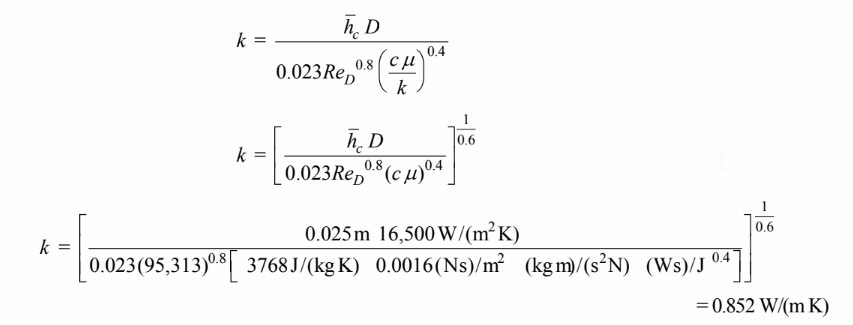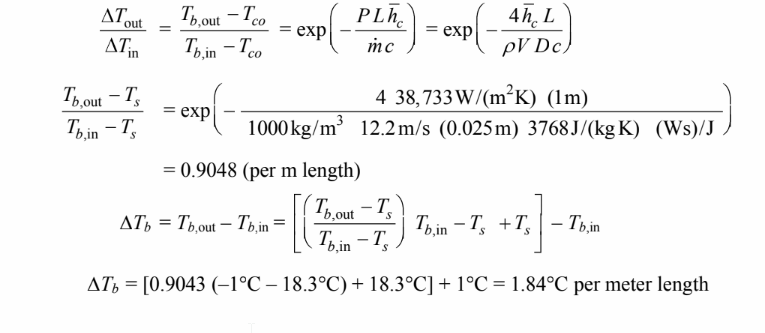In an industrial refrigeration system, brine (10 % NaCl by weight) having a viscosity of 0.0016 (Ns)/m2 and a thermal conductivity of 0.85 W/(m K) is flowing through a long 2.5-cm-ID pipe at 6.1 m/s. Under these conditions, the heat transfer coefficient was found to be 16,500 W/(m2 K). For a brine temperature of –1°C and a pipe temperature of 18.3°C, determine the temperature rise of the brine per meter length of pipe if the velocity of the brine is doubled. Assume that the specific heat of the brine is 3768 J/(kg K) and that its density is equal to that of water.
GIVEN
• Brine flowing through a pipe
• Brine properties
? Viscosity (?) = 0.0016 Ns/m2
? Thermal conductivity (k) = 0.85 W/(m K)
? 10% NaCl by weight
? Specific heat (c) = 3768 J/(kg K)
• Pipe inside diameter (D) = 2.5 cm = 0.025 m
• Brine velocity (V) = 6.1 m/s
• Heat transfer coefficient ( h c) = 16,500 W/(m2 K)
• Brine temperature (Tb) = –1°C
• Pipe temperature (Ts) = 18.3°C FIND
• Temperature rise of the brine per meter length (?Tb/m) if the velocity is doubled (V = 12.2 m/s) ASSUMPTIONS
• Steady state
• Fully developed flow
• Constant and uniform pipe wall temperature
• Density of the brine is the same as water density
SKETCH

PROPERTIES AND CONSTANTS
density (?) of water ? 1000 kg/m3
The Reynolds number at the original velocity is

The thermal conductivity of the fluid can be calculated from the given heat transfer coefficient using
the Dittus-Boelter correlation


The Prandtl number is

The Reynolds number for the new velocity is twice the original Reynolds number:
ReD = 190,626. For fully developed flow

The temperature after one meter is given

You might also like to view...
How large must the coefficient of static friction be between the tires and the road if the car is to round a level curve of radius 85m at a speed of 95 km/h?
What will be an ideal response?
Dark matter had no effect on the distribution of matter in the early universe
Indicate whether the statement is true or false
What power lens is needed to correct for farsightedness where the uncorrected near point is 75 cm?
A) -2.67 D B) +2.67 D C) +5.33 D D) -5.33 D E) +1.00 D
Photoelectrons are ejected when monochromatic light shines on a freshly-prepared (oxide-free) sodium surface. In order to obtain the maximum increase in the number of electrons ejected per second, the experimenter needs to
a. increase the frequency of the light. b. increase the intensity of the light. c. increase the area illuminated by the light. d. do all of the above. e. do only (b) and (c) above.